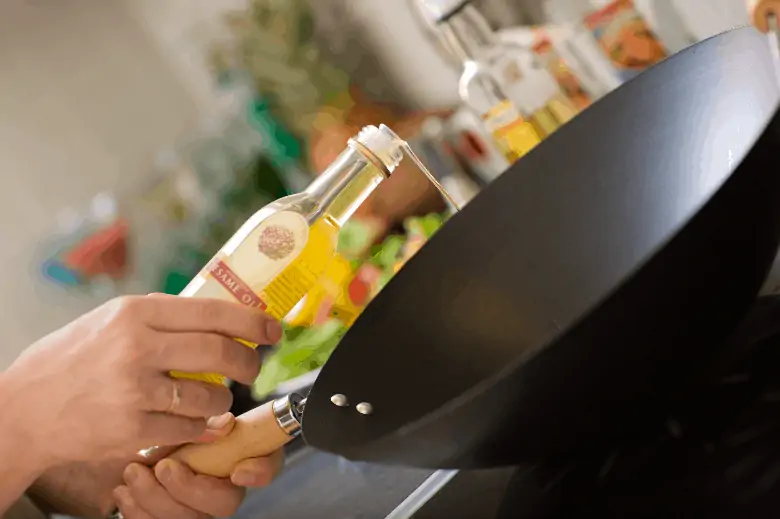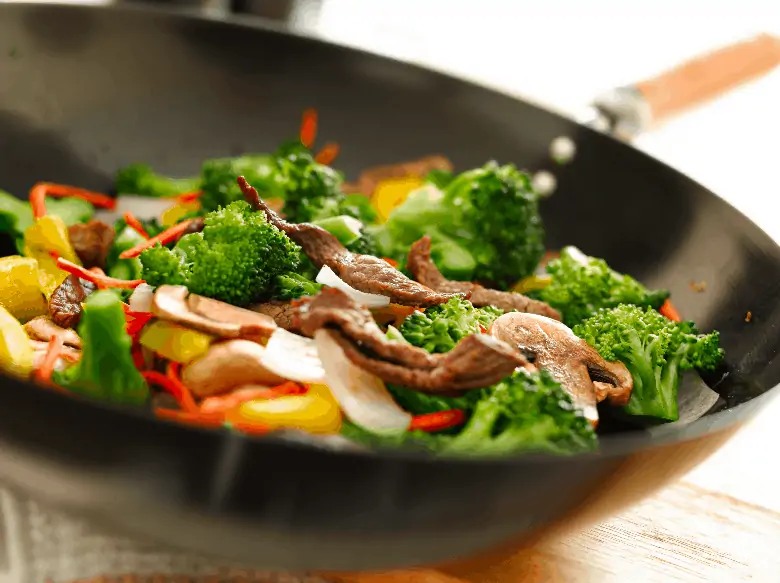If you’ve been told you can’t use a wok on an electric stove, I’m here to tell you that you can. And you should!
A wok is a kitchen workhorse. It’s one of the most versatile pieces of cookware you can own. The hard part is finding the best wok for electric stoves. Especially if you’ve never used one.
Admittedly, I was reluctant to buy a wok. I was always under the assumption they weren’t compatible with an electric stove. That is until I came across a slew of flat-bottomed woks. Bingo!
From lightweight carbon steel to heavy-duty cast iron, I’ll show you my top picks for electric stove woks along with some helpful buying tips. That way you can perfect the art of oil velveting a traditional Chinese stir-fry.
Related: Our Cookware Buying Guide. How To Find Your Perfect Set.
Best Wok for Electric Stoves: Joyce Chen J22-0060 Flat Bottom Wok
The Joyce Chen J22-0060 Flat Bottom Wok is an affordable wok with excellent maneuverability. That, along with great cooking performance, earned it our top spot as the best wok.
The Joyce Chen J22-0060 comes with a long ergonomic handle in addition to a helper handle. Pair that with the lightweight body and you have more control over your high-walled pan. Speaking of which, the 14 inch diameter is just the right size to avoid overcrowding and achieve the ideal sear.
I particularly love that this wok is made from heavy-gauge carbon steel. This offers wonderful heat distribution to properly stir-fry meats and veggies. Additionally, it heats up fast on an electric stove.
Keep in mind carbon steel does require proper seasoning – kind of like cast iron. The Joyce Chen J22-0060 will require some special care to keep it in prime working order.
Pros
Cons
Best for Carbon Steel: Helen’s Asian Kitchen Flat Bottom Wok
Helen’s Asian Kitchen Flat Bottom Wok is style meets function all wrapped up into one efficient flat-bottomed wok. This wok is constructed from 1.6 mm carbon steel so it heats quickly. That means you can go from aromatic garlic to seared steak in no time.
One feature I greatly appreciate is this wok includes a high dome lid. This will allow you to steam gyoza or prevent splattering when making fried chicken. The heat-resistant bamboo handle is also much appreciated.
Note that a natural patina will build up over time. This is normal for carbon steel. As long as you don’t mind the added characters, Helen’s Asian Kitchen 97005 Flat Bottom Wok is an excellent consideration.
Pros
Cons
Best Heavy-Duty Wok: Lodge Pro-Logic Wok
Cast iron is virtually indestructible. This is what makes the Lodge Pro-Logic Wok so great.
The cast-iron Lodge Pro-Logic Wok is a sturdy, heavy-duty wok with excellent heat retention. This makes it a perfect choice for quickly searing meats or frying eggs. You can also use it to braise, bake, boil, or grill.
The Lodge Pro-Logic Wok offers wonderful versatility that’s lacking with other options. You can use it in the oven or over a campfire, in addition to your electric stove. Season the cast iron properly and you’ll be rewarded with exceptional longevity.
The one drawback is that cast iron is famous for hotspots. One trick around this is to preheat the Lodge Pro-Logic in the oven. But be careful, that sucker will be hot!
Pros
Cons
Best Hand Hammered: Mammafong Flat Bottom Carbon Steel Wok
If you’re looking for a more authentic Chinese cooking experience, I highly recommend considering the Mammafong Flat Bottom Carbon Steel Wok. Hand-hammered in Guangdong, China, the Mammafong wok is a pure work of art.
The long single handle and flat base make this wok compatible with a range of stoves, including electric. Smoke, sear, or stir-fry, the 16 gauge carbon steel body offers excellent cooking performance so you can achieve savory Biang Biang noodles or chicken lo mein.
What some may not be too keen on is the cleaning process. The manufacturers state not to use any soap or detergent when cleaning.
However, if you’re the type who refuses to let a drop of dish soap even go near a cast iron skillet, you may not mind a good cleaning ritual with this wok.
Pros
Cons
Best Stainless Steel Wok: Anolon Tri-Ply Clad Stainless Steel Wok
Swear by stainless steel? If you said yes, then take a gander at the 10.75-inch Anolon Tri-Ply Clad Stainless Steel Wok. This wok is highly durable and great for electric stovetops.
You can use it to whip up a quick veggie stir fry, then use it to sear and finish cooking a steak in the oven. That is, as long as cooking temperatures don’t exceed 500°F.
What’s even better is its dishwasher and oven-safe. Many of the other options lack these two perks.
Due to the material, the Anolon Tri-Ply Clad Stainless Steel Wok will require more oil for cooking. Also, the dimensions are smaller. You’ll need to cook multiple servings in batches to avoid overcrowding.
Pros
Cons
Best Nonstick Wok: Calphalon Premier Nonstick Wok
If you can’t veer away from nonstick hard-anodized cookware, you may want to consider the 13-inch Calphalon Premier Nonstick Wok.
This wok features a nonstick coating backed by hard-anodized aluminum. That means you can reduce food sticking to your wok while making cleanup less of a hassle.
The sturdy flat bottom conducts heat relatively well while the handles stay cool to the touch. You can even take the wok from the range to the oven as long as temps don’t exceed 450°F. Plus, the wok is dishwasher safe.
The downfall to choosing an aluminum wok with a nonstick coating over a carbon steel wok is it doesn’t cook as efficiently. However, this material does offer familiarity, reducing the learning curve of cooking with a wok.
Pros
Cons
Best Budget Option: Souped Up Recipes Carbon Steel Wok
The combination of a flat surface, carbon steel, and long handle make the Souped Up Recipes Carbon Steel Wok ideal for an electric stove. Additionally, this wok is easy to use, inexpensive, and comes with a lid and metal spatula making it great for beginners.
I find the unique textured surface enables me to keep veggies on the side while frying salmon in the middle. Meanwhile, the handle design makes it easier to tilt and lift the wok on the stove.
I dig that the Souped Up Recipes Carbon Steel Wok features a spout lip for pouring. I could have used this the last time I made a tofu stir-fry with my favorite Asian garlic sauce.
The one detail I’m not that excited about is the size. This wok has a 12.5-inch diameter. That’s not exactly ideal for larger servings. However, it will work just fine for one, possibly two, people.
Pros
Cons
Buying Guide
Woks Versus Pans
Why even bother with a wok when you have a large 14-inch skillet on hand? While I’m all for a large skillet, they don’t function the same as woks.
For starters, woks require less cooking oil. They heat quickly and feature high walls to prevent splattering. This is something I have yet to achieve when cooking with a skillet.

Additionally, cooked food can be pushed to the sides of the pan while you continue cooking other ingredients in the center. This keeps your ingredients hot while reducing the chance of burning. That’s why they’re so great for stir-frys.
Last but not least, it’s all about the flavor. Woks have ample surface area allowing you to stir all your ingredients, infusing them with all those satiating flavors. Even with my favorite pair of tongs, I find it hard to achieve the same results in a large skillet.
Flat or Round-Bottomed Wok
I’ve come across many individuals who think a wok can only be used with a gas stove. While they’re not entirely wrong, the truth of the matter is it depends on the shape of the wok.
Round-bottom woks need burners designed to evenly heat and hold their curved shape. This requires a specific type of stove. An electric burner lacks the high BTUs, or rather high heat, required for wok stir-frying.
To solve this, you could use a wok ring. This will provide stability but is not ideal for even heating. Wok rings also don’t work well with traditional electric coil ranges.
The best solution to solve this problem is a flat bottom wok. The flat shape enhances stability and heating making them compatible with electric cooktops.
Sear Zone Versus Steam Zone
A wok has two distinct cooking zones: sear and steam. The bottom of the pan is what is known as the sear zone. This is the area that gets the hottest as it’s in more direct contact with the burner. Food cooking in this zone will brown quickly as opposed to the steam zone.
The steam zone is located directly above the sear zone. Food in this zone won’t take on the same browning effect as the sear zone. A wok with a wider base, therefore, will have more space for browning. This is ideal if you plan on cooking more meat-based meals.
Size
Most electric stove woks will range from 10 to 14 inches in diameter. If you’re only feeding yourself, you can get away with a smaller size. However, when it comes to woks I always lean towards the larger end of the scale.
The more surface area you have with a wok, the better. More surface area equals less crowding and more space to work with. This means you can quickly cook your chicken in the sear zone while thoroughly cooking your broccoli and onions in the steam zone.
Another benefit to a larger surface is more room to impressively toss or stir your food. I highly appreciate this feature considering I have a habit of always losing some ingredients to the five-second rule.
I recommend at least a 5-inch width on the bottom of the pan for electric stoves. Anything smaller won’t heat up your wok as efficiently.
Weight
When your wok is full of fried rice, you’ll appreciate a lightweight wok. Lighter woks such as the Joyce Chen J22-0060 Flat Bottom Wok are easier to maneuver than heavy woks like the Lodge Pro-Logic Wok.
What you do get with heavier woks is better stability. However, if you are using a flat bottom wok this won’t matter as much.
Material
Like cookware sets, woks come in a range of materials. Here are the main ones you’ll find.

Carbon Steel
Talk to any chef and you’ll get the same answer, carbon steel is the best for woks. Carbon steel woks are lightweight, durable, and generally inexpensive.
They can be used on a range of stoves and are easy to maneuver. To top that off, they conduct heat quickly and evenly. Braise, sear, or stir-fry, you’ll get sufficient heat with an efficient cooking process.
The one aspect to note is they will require special care. Like cast iron cookware, they need to be seasoned with each use. They will also develop a patina with time which just shows they’ve been put to good use.
Stainless Steel
Stainless steel woks are relatively lightweight and non-reactive with acidic food. They also have a less involved cleaning ritual than carbon steel or cast iron.
The main drawback is food sticks to them more easily. You also should not use metal utensils with them as they will scratch the surface. On the plus side, you don’t have to worry about rust.
Nonstick Hard-Anodized Aluminum
Nonstick hard-anodized aluminum is a less popular choice for woks. I would recommend going with this material only if you highly favor it in your pre-existing cookware. Nonstick hard-anodized aluminum woks will require less oil for cooking and be easier to clean.
The real drawback here is they are heavier. That makes it much harder to control the wok during cooking. Nonstick hard-anodized aluminum also doesn’t heat as well and can’t handle high heat like carbon steel. This makes nonstick hard-anodized aluminum less desirable for stir-frying.
Cast Iron
Cast iron is a great wok material to get sizzling hot. Since this material can withstand high heat it is compatible with the oven, campfire, or grill. So if you need to use it somewhere other than your electric stovetop, you can.
The disadvantage to a cast iron wok is weight. Cast iron is the heaviest material you can cook with. The perk to that is you will get exceptional stability.
Another disadvantage of cast iron is in order to achieve a nonstick surface, the wok will need to be seasoned.
Handles
Woks typically offer two types of handles: a long handle and a helper handle. The long handle lets you maneuver the wok on the electric stove. The helper handle offers more stability and control.
Some woks will come with both of these handles. Others, known as a pow wok, offer only a single long handle. Then there are woks like the Lodge Pro-Logic Wok which only features helper handles.
I find woks that offer a long, angled handle offer the best leverage and control. They make it much easier to tilt, tip, and lift the pan.
You also want to consider the material of the handle itself. Some materials are more heat resistant than others. For instance, Helen’s Asian Kitchen Flat Bottom Wok features heat-resistant wooden handles (bamboo). Meanwhile, stainless steel handles will have you reaching for a towel so you don’t get burned.
Which Electric Stove Wok is Right for You?
Flat bottom woks are the best woks for electric stoves. While there are an endless amount of choices, the Joyce Chen J22-0060 Flat Bottom Wok is our top pick. This wok blends excellent cooking performance with easy-to-use features all at an affordable price.
Some worthy contenders also made our list. For instance, we love the quality of the Mammafong Flat Bottom Carbon Steel Wok. Then there’s Helen’s Asian Kitchen Flat Bottom Wok which is very user-friendly. All of which are terrific options for an electric stove.







